Terrifying simulation reveals why you would not fall out of a rollercoaster if the bar came loose

Obviously this doesn't mean you should now go and ride a rollercoaster without a harness, just so we're clear
A terrifying simulation demonstrates why you probably wouldn't fall out of a rollercoaster seat even if the safety bar failed.
Rollercoasters are fascinating from a physics perspective because they rely so much on gravity to be able to work - strap in because this going to get technical.
 Scream if you wanna go faster! (Vintervit / Getty)
Scream if you wanna go faster! (Vintervit / Getty)
Rollercoaster work on two Newtonian principles - gravity and inertia.
As you gain height on that terrifying crank up the hill the potential force increases which will cause the coaster to accelerate after it goes over the hump.
The rest of the ride is an ingenious way to dissipate that energy in a thrilling, but safe, way.
Gravity acts on an object with a force of 1G, meaning you would accelerate at 9.8m/s if gravity was the only force acting on you.
The other factor is inertia, the principle that an object will stay either at rest or in motion unless another force acts on it.
For a simplified example - a car won't start moving unless you press the gas or slow down unless you apply the brakes.
These two forces interact to make rollercoasters work. Still with me?
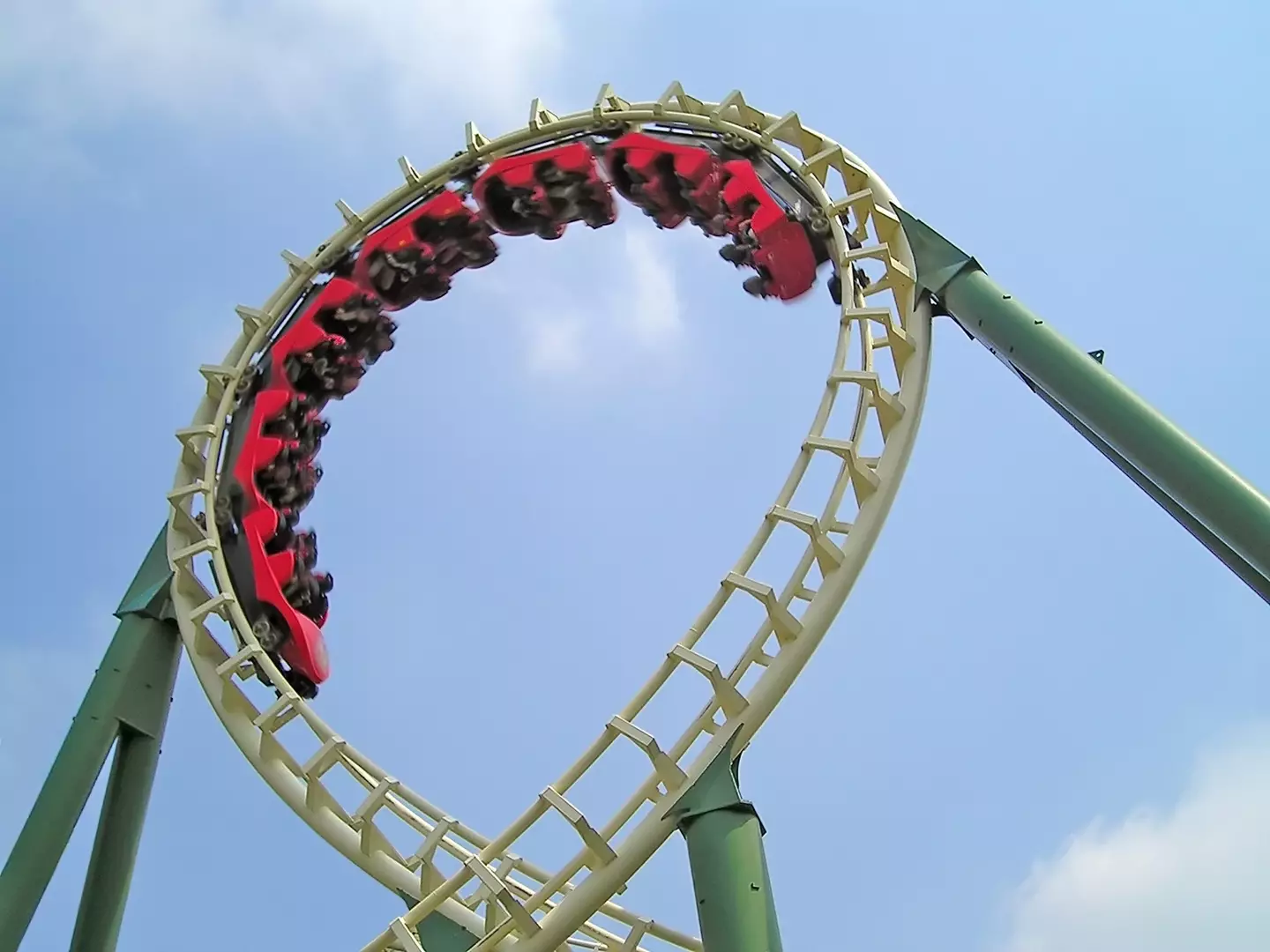 The forces at the top of the loop are balanced (Soldt / Getty)
The forces at the top of the loop are balanced (Soldt / Getty)
A simulation - shared to YouTube by Zack D. Films - shows how momentum is released when a coaster starts accelerating and the strange effect it has when the coaster goes around a loop.
This is all to do with gravitational force, or g-force, which keeps you in your seat when the speeding ride gets to the top of the loop.
While going up you are pushed down into your seat by the combination of inertia and gravity, but at the top of the loop these two factors balance out.
This is why at the top of a loop you might experience a brief feeling of weightlessness.
The coaster then accelerates down the other side before the force of gravity acting on you breaks your inertia.
Here's another way to visualize how this works using things you could have at home.
Let's say you took a small bucket and filled it part way with water, not loads but a little bit, before tying the handle to a length of string or rope and swinging the bucket in a circle.
As long as you keep enough momentum on the swing then the water in the bucket will not fall out, but if the force is not enough then the centrifugal (moving away from a centre) and centripetal (moving towards a centre) forces acting on the water stop, and it falls out.
Obviously this doesn't mean you should now go and ride a rollercoaster without a harness, just so we're clear.
But one thing you can do to get an impression of this next time you're on a ride is to see how much you are pushed into your seat and how much into your safety harness.
That is, if you can stop screaming.Featured Image Credit: YouTube/Zack D. Films
Topics: Science, Weird
NASA simulation reveals terrifying reality of what it would be like going through a black hole
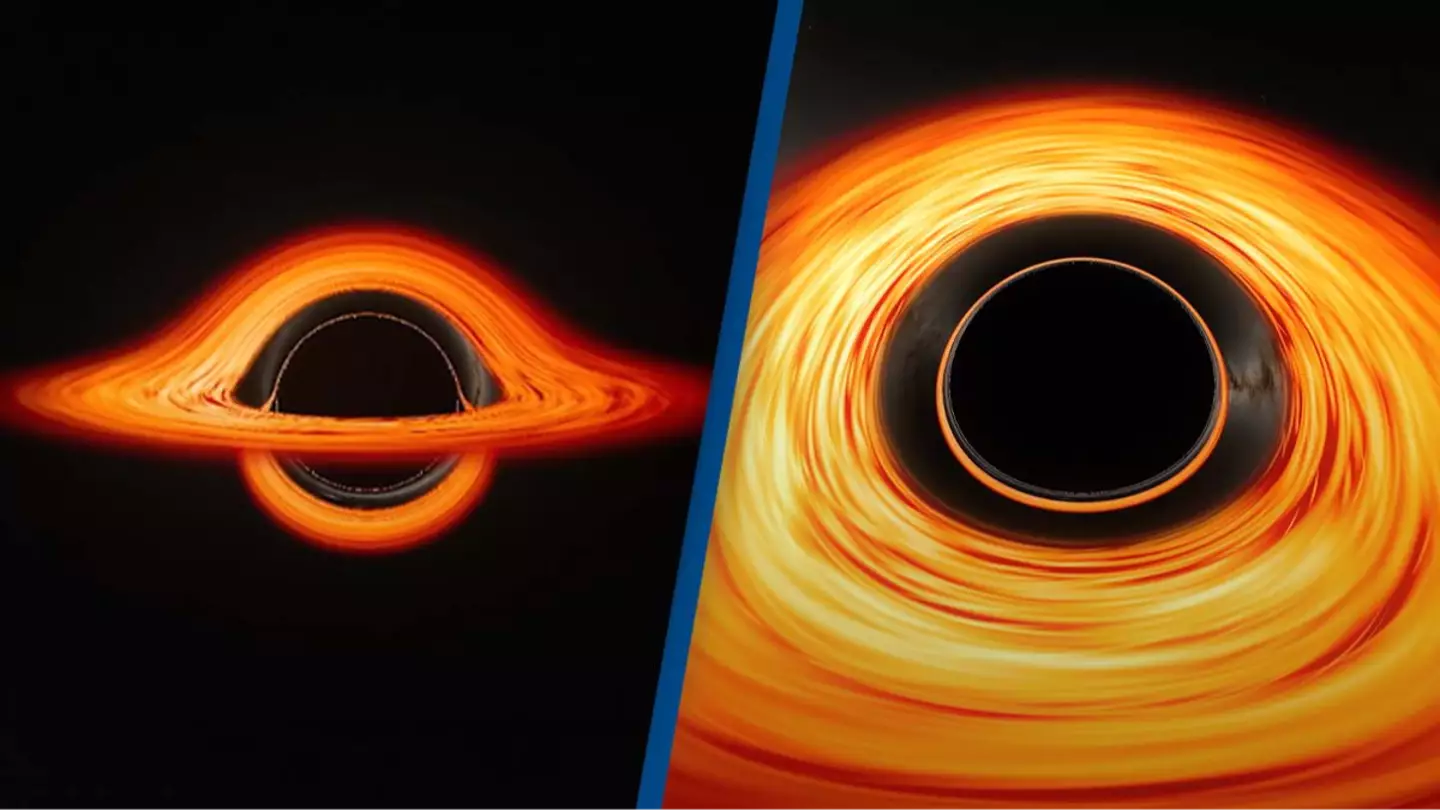
You may have wondered what exactly would happen if you fell into a Black Hole, and now NASA has simulated what it might look like
An expert at NASA has shared what it might look like to fall into a black hole.
It's a question which many of us have asked ourselves and, hopefully, none of us will ever know the answer to from direct experience.
But just in case you were wondering there is now a video put together by an astrophysicist which gives an impression of how it might look.
That is of course assuming that you would be able to see what was going on amidst the weird process of 'spaghettification' where an object being sucked into the black hole would be 'stretched' out indefinitely.
Astrophysicist Jeremy Schnittman at NASA’s Goddard Space Flight Center worked on the video.
It shows what it might look like when someone passed the black hole's event horizon.
This is effectively the point of no return where the gravitational pull of the black hole becomes too strong for their to be any hope of escape.
 Scream if you wanna go faster... (NASA)
Scream if you wanna go faster... (NASA)
Schnittman spoke about the video, explaining why he decided to make it.
He said: “People often ask about this, and simulating these difficult-to-imagine processes helps me connect the mathematics of relativity to actual consequences in the real universe."
In the end there were two scenarios that Schnittman decided to emulate in his videos, which he made using a NASA supercomputer.
He explained: "I simulated two different scenarios, one where a camera — a stand-in for a daring astronaut — just misses the event horizon and slingshots back out, and one where it crosses the boundary, sealing its fate.”
The gravitational pull over the event horizon is so strong that nothing can escape its pull - not even light.
Schnittman explained which sort of black hole would be the best to fall into.
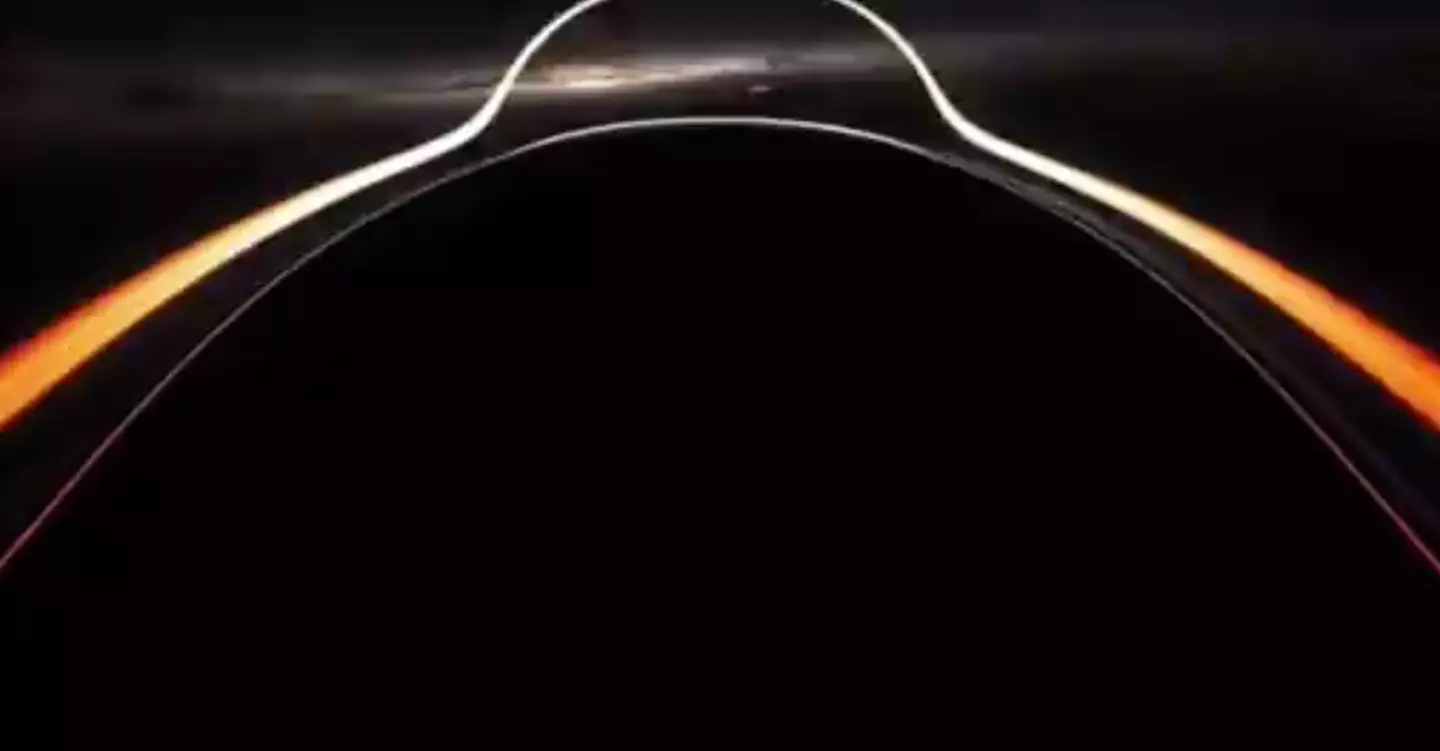 Things aren't looking great. (NASA)
Things aren't looking great. (NASA)
And just to be clear, we don't mean because you might survive, more that the end would be quicker.
He said: “If you have the choice, you want to fall into a supermassive black hole. Stellar-mass black holes, which contain up to about 30 solar masses, possess much smaller event horizons and stronger tidal forces, which can rip apart approaching objects before they get to the horizon.”
Not only that but you might even experience time differently if you were to get close enough to a black hole.
To an observer you might appear to never pass the event horizon even though you had.
And if you went on a trip where you were sling-shotted round by gravity then you would come back younger.
Don't get your hopes though, as it would only be by around 36 minutes.Featured Image Credit: NASA
Topics: News, NASA, Science, US News, World News, Space
Terrifying animation shows what would happen if the moon crashed into the Earth

An animation showing the destructive power of the moon if it crashed into Earth has put social media users on edge.
An animation of what it would look like if the moon came crashing down on Earth has made people more than a little nervous.
Admittedly, most people don’t tend to fear that the Moon is going to crash into Earth and destroy everything.
For a few reasons, 1) we have more important things to worry about and 2) it's incredibly unlikely.
Yep, Moonfall lied to you.
The truth is it would take a truly massive collision to disrupt the Moon and Earth's stable orbit enough to cause a collision, and nothing like that is on the cards in the foreseeable future.
The Moon is stuck orbiting the Earth, moving at rapid speeds and preventing it from falling on our heads.
Even if you somehow managed to got the orbit to stop, the rock in the sky wouldn’t strike the planet as a whole but rather be scattered across the sky into little pieces, similar to the rings of Saturn, according to educational channel Kurzgesagt.
By that point, life on Earth will likely be wiped out by earthquakes, volcanoes, rapid cooling and acid rain - but still.
Nevertheless, an animation showing what it would look like if the Moon struck Earth has concerned some social media users.
Well, concerned some, many Reddit users that watched the animation felt the best way to deal with the possibility of major life extinction was jokes and to be honest what is life without some laughter.
The animation shows a first-person view of what it would be like in New York if the moon decided to come careening towards the planet.
 MetaBallStudios/YouTube
MetaBallStudios/YouTube
Things go as well as you would expect, mass destruction and chaos before a wall of fire engulfs, from the impact, envelops the entire surface of the planet.
“I think what we’ve learned from this is that the moon is dangerous and therefore needs to destroyed,” one user joked.
“Most of us already know 'Moon hit Earth. Very bad. Everyone die',” commented another.
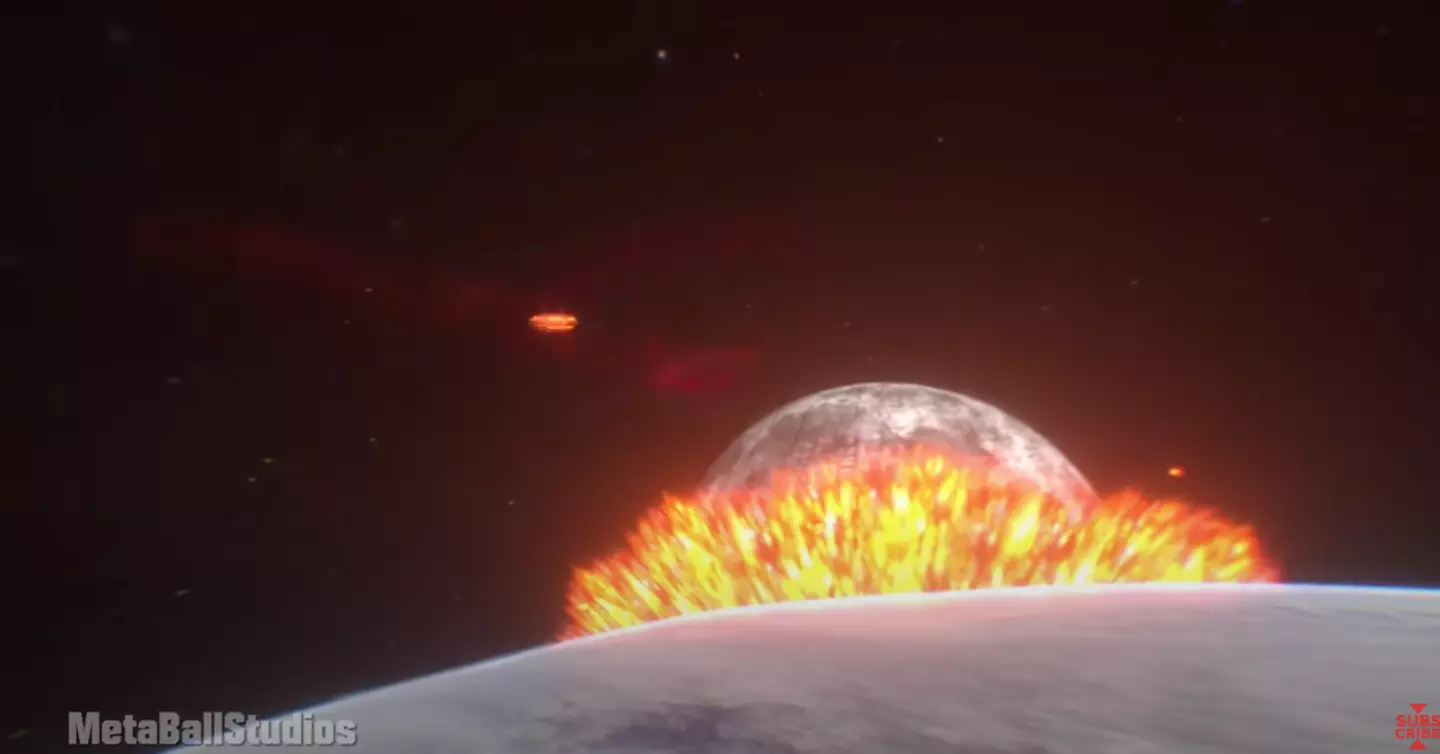 YouTube/MetaBallStudios
YouTube/MetaBallStudios
“I watched this and my only thought was, 'even at the end of the world and while everything is being obliterated people still cannot put their phones down and will try and post this on TikTok in the last seconds,” joked a third.
“In reality this wouldn’t happen. We know that if the Moon came within the Earth's atmosphere, it’d be torn apart and form a ring of miniature asteroids like those around Saturn.
"The video is BS. Fun to watch, but a complete waste of time if you’re looking for accuracy,” another added.
While the Moon isn't going to come crashing down on our heads anytime soon, it's still fascinating to think about.Featured Image Credit: YouTube/MetaBallStudios
Topics: Science, Space, Reddit
If you hate words like 'moist' there's actually a scientific reason behind it

Why does the thought of wearing 'panties' or being prescribed an 'ointment' give us the ick?
Moist. Phlegm. Ooze. To most people, they're just words. But for some, the mere thought of them makes them shudder. But what is it about certain words that gives us the ick?
Word aversion refers to the visceral, irrational disgust that we feel when we hear, or even see, a particular word, like nails screeching down a chalkboard.
 Pexels/Pavel Danilyuk
Pexels/Pavel Danilyuk
University of Pennsylvania linguistics professor Mark Liberman defined the concept as 'a feeling of intense, irrational distaste for the sound or sight of a particular word or phrase, not because its use is regarded as etymologically or logically or grammatically wrong, but simply because the word itself somehow feels unpleasant'.
'Moist' is a prime example, but a New York Times survey found other icky words include 'slacks,' 'loin' and 'panties'.
While certain words trigger us because of the things they refer to (i.e. phlegm), our disgust in others is directed at the word itself. These words aren't offensive or taboo semantically, yet they evoke an almost primal response in certain people.
But why?
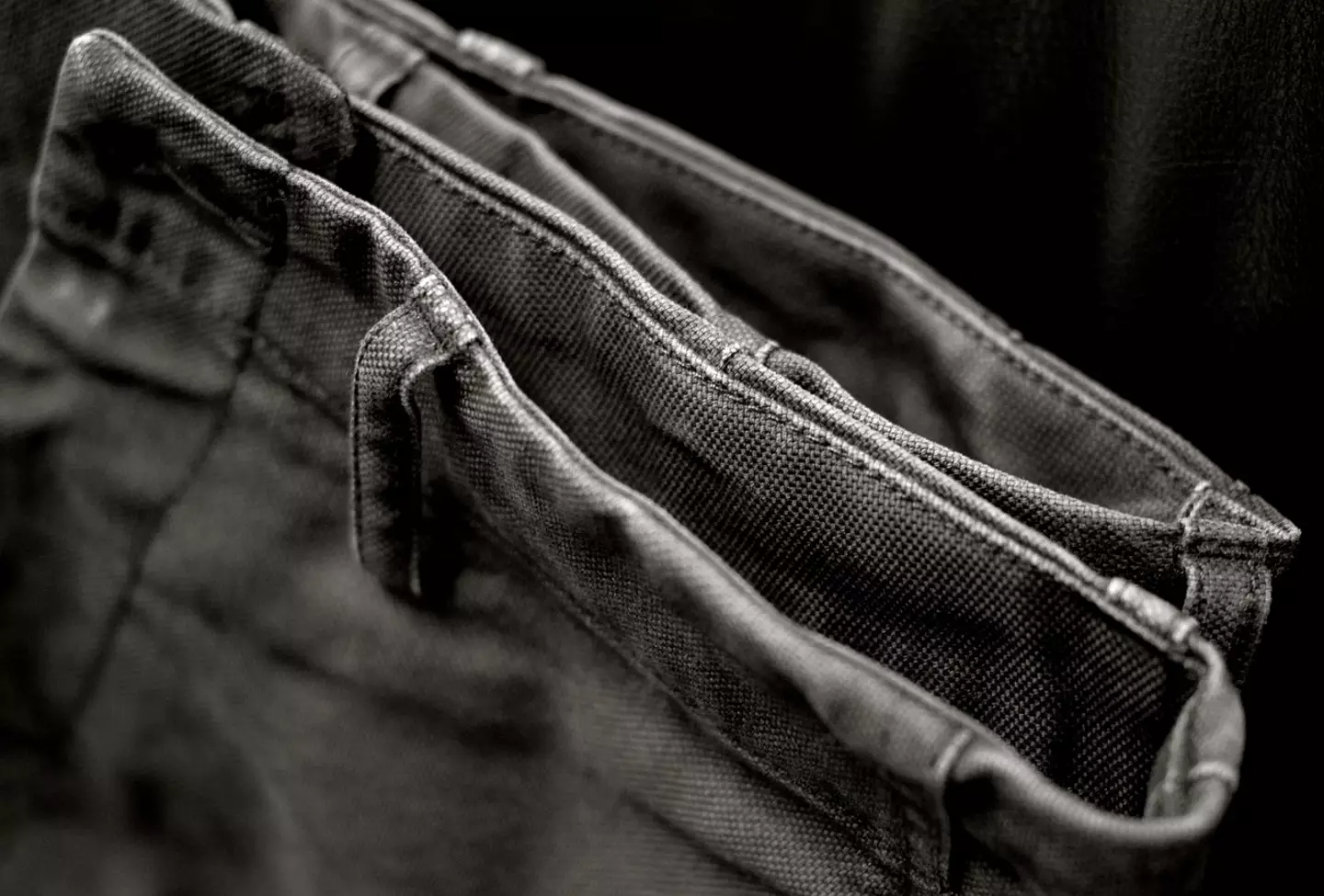 Pixabay/Jirreaux
Pixabay/Jirreaux
Neuroscientist David Eagleman suggests that the sound of the word may be a factor.
“There appears to be this relationship between phonological probability and aversion,” said Eagleman. “In other words, something that is improbable, something that doesn’t sound like it should belong in your language, has this emotional reaction that goes along with it.”
Another thing that cannot be ignored is social contagion, which was mentioned in a 2016 study published in the journal PLOS ONE.
Pop culture is full of jokes about people hating the word 'moist.' This likely explains why so many people continue to recoil from it.
Linguistics professor, Jason Riggle explained to Slate: “Given that, as far back as the aughts, there were comedians making jokes about hating [moist], people who were maybe prone to have that kind of reaction to one of these words, surely have had it pointed out to them that it’s an icky word.
"So, to what extent is it really some sort of innate expression that is independently arrived at, and to what extent is it sort of socially transmitted? Disgust is really a very social emotion."
While current research on the topic is limited, scientists are getting closer to unpicking what it is that makes your toes curl when your doctor prescribes an ointment or a cafe menu lists its moist chocolate fudge cake so don't get your panties in a twist.
Hope that didn't put you off your dinner!Featured Image Credit: Getty Stock Image/Pexels
Topics: Science, Weird
Reason why February has an extra day this year and what would happen if it didn't

February 29th only comes around every four years
I hate to break it to you folks, but you'll have to wait an extra day for payday this month.
2024 marks another leap year, meaning that the month with end on the 29th instead of the 28th (therefore adding an extra 24 hours for our pay cheques to land).
There are dozens of leap year traditions across the globe. In Ireland, they say that a woman can propose to a man on February 29 - as depicted in the Amy Adams classic, Leap Year.
Meanwhile in Texas, they have a leap year festival to celebrate babies born on February 29.
The state has previously dubbed itself as the 'Leap Year Capital of the World'.
This year's festival is set to take place in Anthony over March 1-2, and will involve 'endless fun for family and friends', as per the festival's official website.
But why do we have leap years, I hear you ask?
It's because each year isn't technically 365 days long. In fact, it takes Earth an awkward 365.242190 days to orbit the Sun - and the .242190 is the entire reason we have an extra day (almost) every four years.
 Darren Robb/Getty Stock
Darren Robb/Getty Stock
Back in a time when you couldn't rely on your handy Google Calendar to check the date, ancient civilizations had to use the cosmos to plan their lives.
Under Julius Caesar's reign, he introduced his Julian calendar in 46 BCE - a purely solar calendar that counted each year at 365.25 days.
This method introduced an extra day every four years to compensate for the .25.
But his calendar wasn't quite right as it was 0.0078 days longer than the tropical year, so Pope Gregory XIII introduced some amendments to Caesar's calendar in the 16th century so that leap years weren't quite every four years. For example, there won't be a leap year in 2100, 2200, 2300.
This is the calendar we still use to this day.
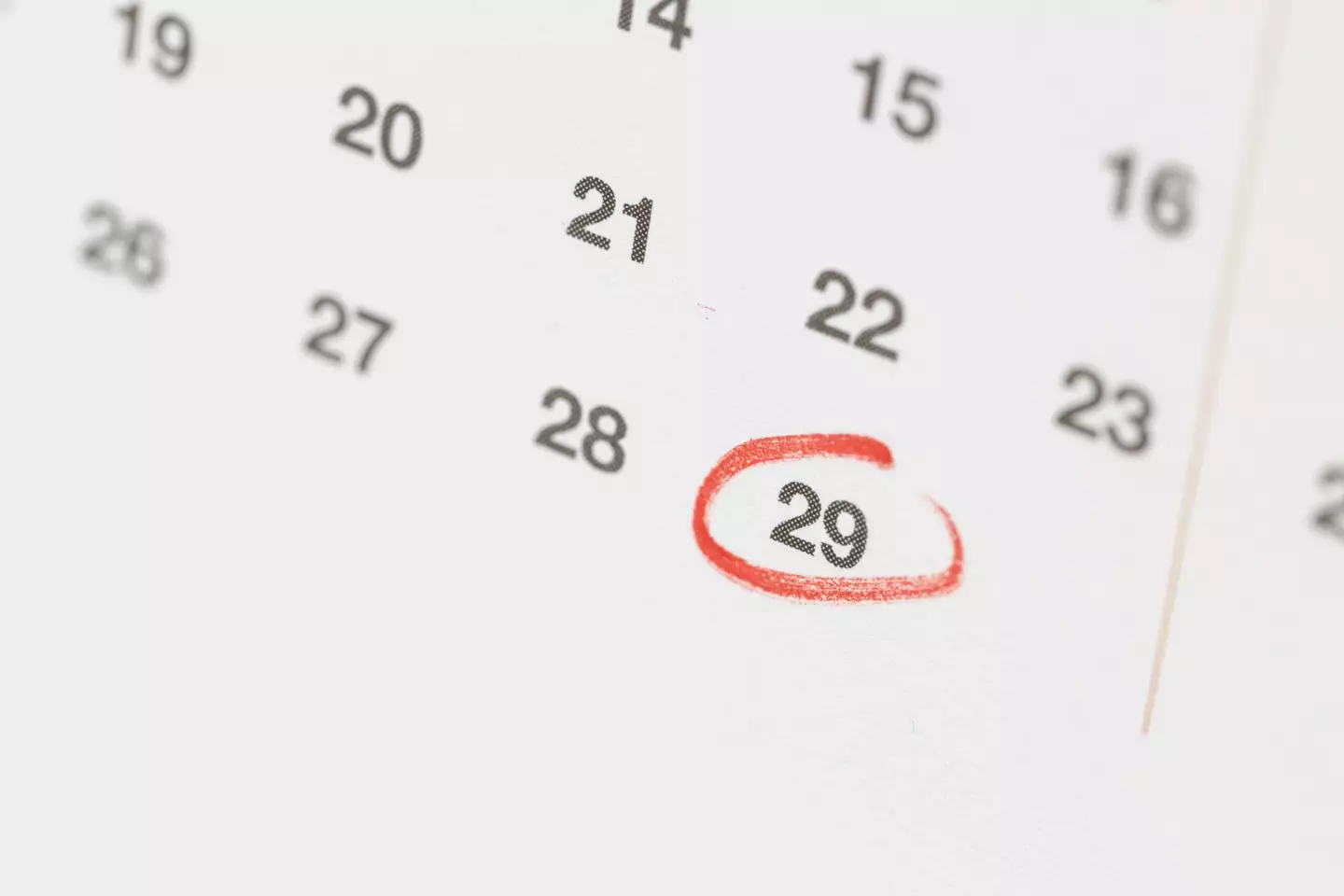 Andres Victorero/Getty Stock
Andres Victorero/Getty Stock
As to what would happen without the addition of the pesky and confusing February 29, our seasons would start shifting.
Younas Khan, a physics instructor at the University of Alabama at Birmingham, explained to The Independent: "Without the leap years, after a few hundred years we will have summer in November.
"Christmas will be in summer. There will be no snow. There will be no feeling of Christmas."
If only the solar year was a perfect 365.25 years, hey?

Obviously this doesn't mean you should now go and ride a rollercoaster without a harness, just so we're clear
A terrifying simulation demonstrates why you probably wouldn't fall out of a rollercoaster seat even if the safety bar failed.
Rollercoasters are fascinating from a physics perspective because they rely so much on gravity to be able to work - strap in because this going to get technical.
 Scream if you wanna go faster! (Vintervit / Getty)
Scream if you wanna go faster! (Vintervit / Getty)Rollercoaster work on two Newtonian principles - gravity and inertia.
As you gain height on that terrifying crank up the hill the potential force increases which will cause the coaster to accelerate after it goes over the hump.
The rest of the ride is an ingenious way to dissipate that energy in a thrilling, but safe, way.
Gravity acts on an object with a force of 1G, meaning you would accelerate at 9.8m/s if gravity was the only force acting on you.
The other factor is inertia, the principle that an object will stay either at rest or in motion unless another force acts on it.
For a simplified example - a car won't start moving unless you press the gas or slow down unless you apply the brakes.
These two forces interact to make rollercoasters work. Still with me?
 The forces at the top of the loop are balanced (Soldt / Getty)
The forces at the top of the loop are balanced (Soldt / Getty)A simulation - shared to YouTube by Zack D. Films - shows how momentum is released when a coaster starts accelerating and the strange effect it has when the coaster goes around a loop.
This is all to do with gravitational force, or g-force, which keeps you in your seat when the speeding ride gets to the top of the loop.
While going up you are pushed down into your seat by the combination of inertia and gravity, but at the top of the loop these two factors balance out.
This is why at the top of a loop you might experience a brief feeling of weightlessness.
The coaster then accelerates down the other side before the force of gravity acting on you breaks your inertia.
Here's another way to visualize how this works using things you could have at home.
Let's say you took a small bucket and filled it part way with water, not loads but a little bit, before tying the handle to a length of string or rope and swinging the bucket in a circle.
As long as you keep enough momentum on the swing then the water in the bucket will not fall out, but if the force is not enough then the centrifugal (moving away from a centre) and centripetal (moving towards a centre) forces acting on the water stop, and it falls out.
Obviously this doesn't mean you should now go and ride a rollercoaster without a harness, just so we're clear.
But one thing you can do to get an impression of this next time you're on a ride is to see how much you are pushed into your seat and how much into your safety harness.
That is, if you can stop screaming.Featured Image Credit: YouTube/Zack D. Films
Topics: Science, Weird
NASA simulation reveals terrifying reality of what it would be like going through a black hole

You may have wondered what exactly would happen if you fell into a Black Hole, and now NASA has simulated what it might look like
An expert at NASA has shared what it might look like to fall into a black hole.
It's a question which many of us have asked ourselves and, hopefully, none of us will ever know the answer to from direct experience.
But just in case you were wondering there is now a video put together by an astrophysicist which gives an impression of how it might look.
That is of course assuming that you would be able to see what was going on amidst the weird process of 'spaghettification' where an object being sucked into the black hole would be 'stretched' out indefinitely.
Astrophysicist Jeremy Schnittman at NASA’s Goddard Space Flight Center worked on the video.
It shows what it might look like when someone passed the black hole's event horizon.
This is effectively the point of no return where the gravitational pull of the black hole becomes too strong for their to be any hope of escape.
 Scream if you wanna go faster... (NASA)
Scream if you wanna go faster... (NASA)Schnittman spoke about the video, explaining why he decided to make it.
He said: “People often ask about this, and simulating these difficult-to-imagine processes helps me connect the mathematics of relativity to actual consequences in the real universe."
In the end there were two scenarios that Schnittman decided to emulate in his videos, which he made using a NASA supercomputer.
He explained: "I simulated two different scenarios, one where a camera — a stand-in for a daring astronaut — just misses the event horizon and slingshots back out, and one where it crosses the boundary, sealing its fate.”
The gravitational pull over the event horizon is so strong that nothing can escape its pull - not even light.
Schnittman explained which sort of black hole would be the best to fall into.
 Things aren't looking great. (NASA)
Things aren't looking great. (NASA)And just to be clear, we don't mean because you might survive, more that the end would be quicker.
He said: “If you have the choice, you want to fall into a supermassive black hole. Stellar-mass black holes, which contain up to about 30 solar masses, possess much smaller event horizons and stronger tidal forces, which can rip apart approaching objects before they get to the horizon.”
Not only that but you might even experience time differently if you were to get close enough to a black hole.
To an observer you might appear to never pass the event horizon even though you had.
And if you went on a trip where you were sling-shotted round by gravity then you would come back younger.
Don't get your hopes though, as it would only be by around 36 minutes.Featured Image Credit: NASA
Topics: News, NASA, Science, US News, World News, Space
Terrifying animation shows what would happen if the moon crashed into the Earth

An animation showing the destructive power of the moon if it crashed into Earth has put social media users on edge.
An animation of what it would look like if the moon came crashing down on Earth has made people more than a little nervous.
Admittedly, most people don’t tend to fear that the Moon is going to crash into Earth and destroy everything.
For a few reasons, 1) we have more important things to worry about and 2) it's incredibly unlikely.
Yep, Moonfall lied to you.
The truth is it would take a truly massive collision to disrupt the Moon and Earth's stable orbit enough to cause a collision, and nothing like that is on the cards in the foreseeable future.
The Moon is stuck orbiting the Earth, moving at rapid speeds and preventing it from falling on our heads.
Even if you somehow managed to got the orbit to stop, the rock in the sky wouldn’t strike the planet as a whole but rather be scattered across the sky into little pieces, similar to the rings of Saturn, according to educational channel Kurzgesagt.
By that point, life on Earth will likely be wiped out by earthquakes, volcanoes, rapid cooling and acid rain - but still.
Nevertheless, an animation showing what it would look like if the Moon struck Earth has concerned some social media users.
Well, concerned some, many Reddit users that watched the animation felt the best way to deal with the possibility of major life extinction was jokes and to be honest what is life without some laughter.
The animation shows a first-person view of what it would be like in New York if the moon decided to come careening towards the planet.
 MetaBallStudios/YouTube
MetaBallStudios/YouTubeThings go as well as you would expect, mass destruction and chaos before a wall of fire engulfs, from the impact, envelops the entire surface of the planet.
“I think what we’ve learned from this is that the moon is dangerous and therefore needs to destroyed,” one user joked.
“Most of us already know 'Moon hit Earth. Very bad. Everyone die',” commented another.
 YouTube/MetaBallStudios
YouTube/MetaBallStudios“I watched this and my only thought was, 'even at the end of the world and while everything is being obliterated people still cannot put their phones down and will try and post this on TikTok in the last seconds,” joked a third.
“In reality this wouldn’t happen. We know that if the Moon came within the Earth's atmosphere, it’d be torn apart and form a ring of miniature asteroids like those around Saturn.
"The video is BS. Fun to watch, but a complete waste of time if you’re looking for accuracy,” another added.
While the Moon isn't going to come crashing down on our heads anytime soon, it's still fascinating to think about.Featured Image Credit: YouTube/MetaBallStudios
Topics: Science, Space, Reddit
If you hate words like 'moist' there's actually a scientific reason behind it

Why does the thought of wearing 'panties' or being prescribed an 'ointment' give us the ick?
Moist. Phlegm. Ooze. To most people, they're just words. But for some, the mere thought of them makes them shudder. But what is it about certain words that gives us the ick?
Word aversion refers to the visceral, irrational disgust that we feel when we hear, or even see, a particular word, like nails screeching down a chalkboard.
 Pexels/Pavel Danilyuk
Pexels/Pavel DanilyukUniversity of Pennsylvania linguistics professor Mark Liberman defined the concept as 'a feeling of intense, irrational distaste for the sound or sight of a particular word or phrase, not because its use is regarded as etymologically or logically or grammatically wrong, but simply because the word itself somehow feels unpleasant'.
'Moist' is a prime example, but a New York Times survey found other icky words include 'slacks,' 'loin' and 'panties'.
While certain words trigger us because of the things they refer to (i.e. phlegm), our disgust in others is directed at the word itself. These words aren't offensive or taboo semantically, yet they evoke an almost primal response in certain people.
But why?
 Pixabay/Jirreaux
Pixabay/JirreauxNeuroscientist David Eagleman suggests that the sound of the word may be a factor.
“There appears to be this relationship between phonological probability and aversion,” said Eagleman. “In other words, something that is improbable, something that doesn’t sound like it should belong in your language, has this emotional reaction that goes along with it.”
Another thing that cannot be ignored is social contagion, which was mentioned in a 2016 study published in the journal PLOS ONE.
Pop culture is full of jokes about people hating the word 'moist.' This likely explains why so many people continue to recoil from it.
Linguistics professor, Jason Riggle explained to Slate: “Given that, as far back as the aughts, there were comedians making jokes about hating [moist], people who were maybe prone to have that kind of reaction to one of these words, surely have had it pointed out to them that it’s an icky word.
"So, to what extent is it really some sort of innate expression that is independently arrived at, and to what extent is it sort of socially transmitted? Disgust is really a very social emotion."
While current research on the topic is limited, scientists are getting closer to unpicking what it is that makes your toes curl when your doctor prescribes an ointment or a cafe menu lists its moist chocolate fudge cake so don't get your panties in a twist.
Hope that didn't put you off your dinner!Featured Image Credit: Getty Stock Image/Pexels
Topics: Science, Weird
Reason why February has an extra day this year and what would happen if it didn't

February 29th only comes around every four years
I hate to break it to you folks, but you'll have to wait an extra day for payday this month.
2024 marks another leap year, meaning that the month with end on the 29th instead of the 28th (therefore adding an extra 24 hours for our pay cheques to land).
There are dozens of leap year traditions across the globe. In Ireland, they say that a woman can propose to a man on February 29 - as depicted in the Amy Adams classic, Leap Year.
Meanwhile in Texas, they have a leap year festival to celebrate babies born on February 29.
The state has previously dubbed itself as the 'Leap Year Capital of the World'.
This year's festival is set to take place in Anthony over March 1-2, and will involve 'endless fun for family and friends', as per the festival's official website.
But why do we have leap years, I hear you ask?
It's because each year isn't technically 365 days long. In fact, it takes Earth an awkward 365.242190 days to orbit the Sun - and the .242190 is the entire reason we have an extra day (almost) every four years.
 Darren Robb/Getty Stock
Darren Robb/Getty StockBack in a time when you couldn't rely on your handy Google Calendar to check the date, ancient civilizations had to use the cosmos to plan their lives.
Under Julius Caesar's reign, he introduced his Julian calendar in 46 BCE - a purely solar calendar that counted each year at 365.25 days.
This method introduced an extra day every four years to compensate for the .25.
But his calendar wasn't quite right as it was 0.0078 days longer than the tropical year, so Pope Gregory XIII introduced some amendments to Caesar's calendar in the 16th century so that leap years weren't quite every four years. For example, there won't be a leap year in 2100, 2200, 2300.
This is the calendar we still use to this day.
 Andres Victorero/Getty Stock
Andres Victorero/Getty StockAs to what would happen without the addition of the pesky and confusing February 29, our seasons would start shifting.
Younas Khan, a physics instructor at the University of Alabama at Birmingham, explained to The Independent: "Without the leap years, after a few hundred years we will have summer in November.
"Christmas will be in summer. There will be no snow. There will be no feeling of Christmas."
If only the solar year was a perfect 365.25 years, hey?

